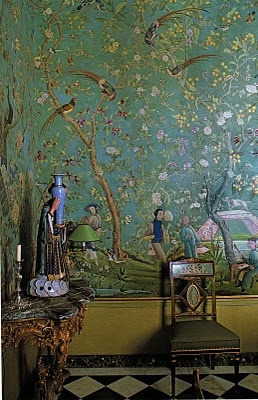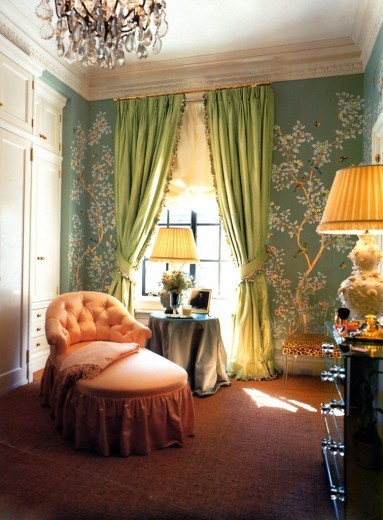As a follow up to my Griffin and Wong post, I thought I would post a little chinoiserie wallpaper inspiration. I also learned more about the history of the wallpaper from their site and thought you might like to read it as well.
Chinese silk wallcoverings are one of the earliest global luxury products. Originally, the exclusive domain of Ming Dynasty Chinese nobility, by the 18th Century, the papers had also been widely adopted by the English and French nobility as the high-water mark of interior design. In France, they were known at the Louis XIV Versailles court as” papiers peints panoramique”.
Chinoiserie wallpapers that depicted flowers, birds and butterflies subsequently became the rage of the day with the affluent 18th and 19th Century European Commercial class, and became a standard of elegant living during this period. With the gradual shift of wealth and power to the New World, silk wallpapering followed, and the look became closely associated with the rise of the railroad and manufacturing dynasties of the Vanderbilt, Huntington and Carnegies (many fine examples of silk wallpapering still exist in Newport and other Eastern US historic homes).
via de Gournay
via de Gournay
Yves Saint Laurent and Pierre Berger residence.
de Gournay
Marjorie Gubelmann apartment via Elle Decor.
De Gournay wallpaper in Balfour Castle.
Tory Burch residence,
Pauline de Rothschild
Aerin Lauder dressing room.
Elsie de Wolfe residence.
via Thomas Jayne
Elsie de Wolfe bedroom.
via Michael Smith
Pauline de Rothschild residence.
Ann Getty residence
Abbotsford House
de Gournay
Aerin Lauder dressing room again.
Ann Getty residence via Harper's Bazaar.
Martha Angus
Miles Redd via Elle Decor
Jeffrey Bilbuber
Thad Hayes room with Gracie wallpaper.
via Thomas Jayne.
Janklow residence.





























q9c50e9l11 k3m23z7s47 o7t68t8u74 l9n69y4l04 y8u21l4l57 n9t77v5s23
ReplyDeletet6x50j4w33 l4c64b9w82 j1z94m5w81 n0a60q8g52 v0x62a4d50 s0x85z7b35
ReplyDelete